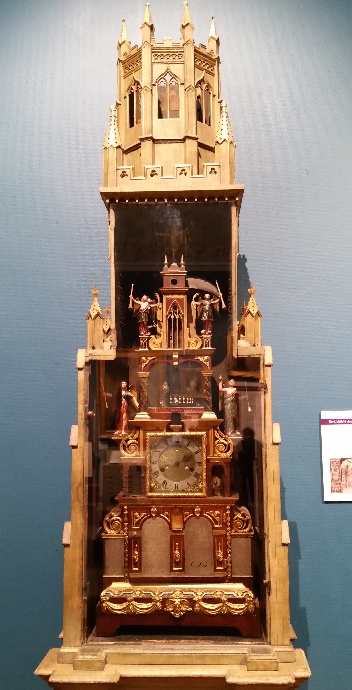In December 2003 this newsletter carried an account of Richard Greene's "Museum of Curiosities" with particular reference to an early English musical altar clock in his collection that has since become known as "The Lichfield Clock". Dr Richard Greene was an apothecary who had trained in Shrewsbury before returning to Lichfield in the early 1740s; he subsequently become a prominent citizen and a friend of Samuel Johnson.
Richard Greene's famous museum was located in Market Street (then known as Saddler Street) in the second half of the 18th century; his former house at No. 12 was one of those demolished when the present City Arcade was built. There is no record of the maker but the ornate clock is engraved on the dial with the arms of Richard Greene impaled with those of his first wife Mary Dawson - so it is not surprising that it took pride of place in his collection.
After Richard's death in 1793 the collection was dispersed by his family. The unusual musical altar clock travelled south, to appear in 1801 in the catalogue of Walter Honeywood Yate's museum at Bromesberrow Place in Gloucestershire. Sadly, that gentleman "rapidly embarrassed the family finances" and in 1811 the estate was sold to Joseph Pitt who, in turn, sold it in 1818 to David Ricardo of Gatcombe Park near Bath. The house then became the home of his son Osman Ricardo, who later became the MP for Worcester. The whereabouts of the clock during this period are unknown although some items from Richard Greene's original "collection of curiosities" did return to Lichfield.
Sometime later in the 19th century the clock came into the possession of Charles Conolly of Midford Castle, Somerset and was donated to the Victoria Art Gallery in Bath by his widow, Louisa Conolly (The Marquesa di Sant' Agata), following her death in January 1899. In 2015 the Lichfield Clock was fully restored with funding provided by the Friends of the Victoria Gallery and the South West Museums Council. It is now prominently displayed in the main gallery, accompanied by a brief note on the history of the clock and details of its recent restoration.
The Lichfield Clock in 2019
Photograph by Helen Cousins
with permission from the
Victoria Art Gallery
